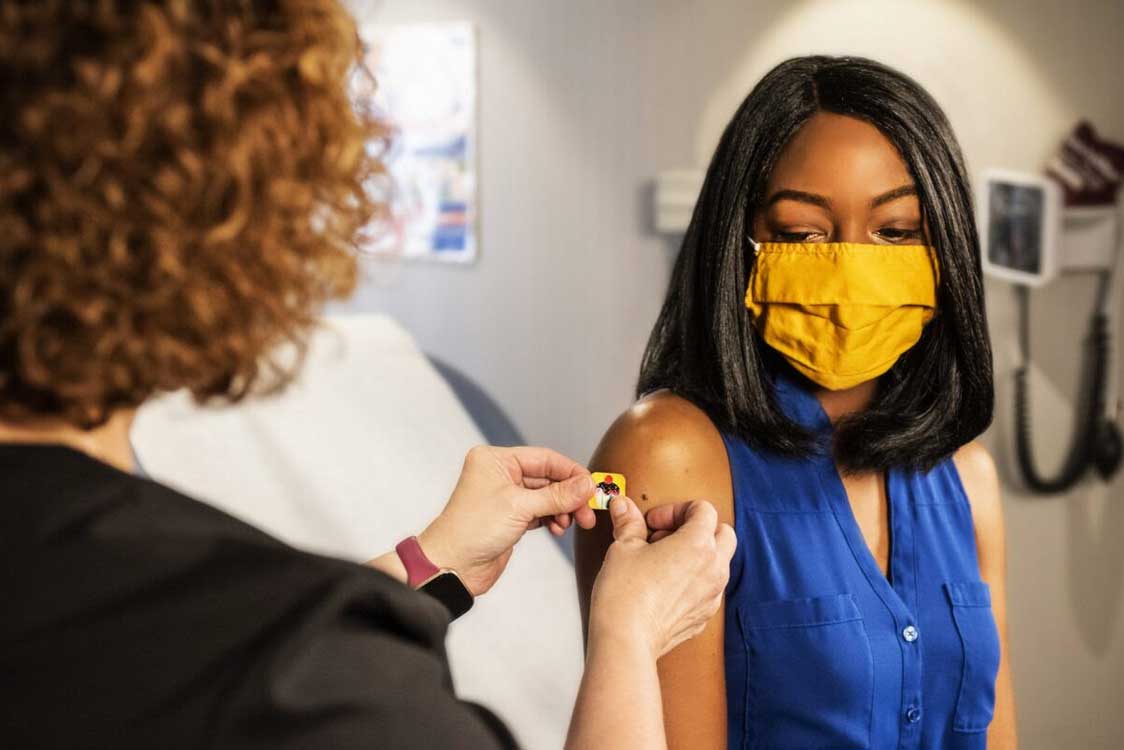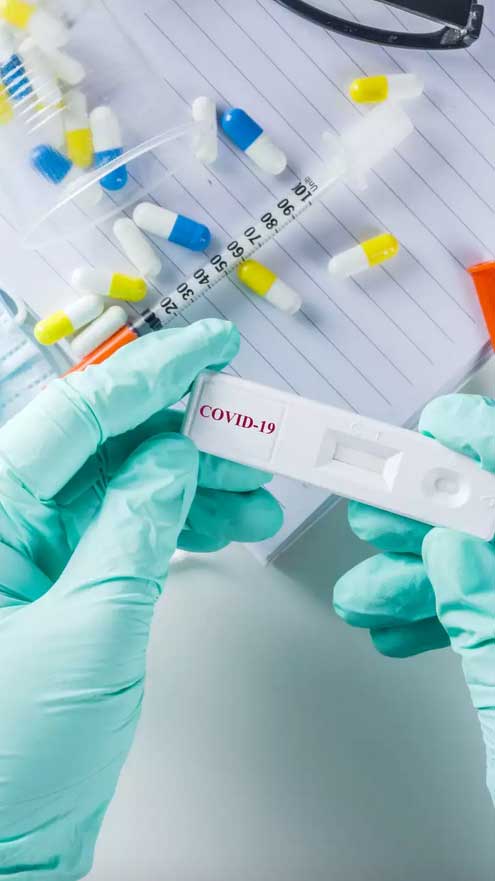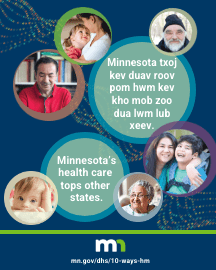COVID Makes A Comeback, But New Vaccines Are Around The Corner
By Sunita Sohrabji
Story courtesy Ethnic Media Services
The U.S. is experiencing a summer swell of infections, though hospitalization rates remain relatively stable. Three eminent experts conclude that COVID-19 will continue to pose a health threat over many years, as it continues its evolution. But updated vaccines are expected to mitigate the severity of infections.
COVID-19 cases are rising once again, possibly fueled by the emergence of the EG.5 variant. Hospitalization rates jumped by 12.5% nationwide in July, according to data from the Centers for Disease Control and Prevention. This uptick comes even as the public health emergency has ended, taking with it free testing and therapeutics. And Covid fatigue has set in. People no longer wear masks in public, and a study has determined that the majority of Americans will forego new boosters, which will be available this fall.
At an August 11 panel discussion organized by Ethnic Media Services, three eminent COVID experts examined the rise in cases, the new variant, and the new monovalent vaccine which will be available this fall.
Panelists included:
- Peter Chin-Hong, Associate Dean for Regional Campuses, University of California, San Francisco and Medical Educator, specializing in treating infectious diseases
- Benjamin Neuman, Professor of Biology and Chief Virologist, Global Health Research Complex, Texas A&M University
- William Schaffner, Professor of Preventive Medicine and Infectious Diseases, Vanderbilt University School of Medicine
What are the origins of the EG.5 variant? Does it differ substantially from its predecessors?
Dr. Neuman: EG.5 is one of the variants that’s spreading the fastest right now. It is a child of a thing called XBB 1.9. Basically, it’s another version of Omicron. And everything that is circulating in the world right now has about 100 to 110 differences from the original version.
This variant is spreading because it has a lot of changes at the receptor binding site that is the target of most of the vaccines and of some of the most useful parts of the immune system.
Will the new vaccines recognize the new variant and be effective against it?
Dr. Neuman: When the target changes, you have to change your aim. It has been over a year since we have had an updated version of the vaccine. It’s coming slowly, but uptake has not been great. The total uptake in the US for the bivalent vaccine is only 17%.
The formulation of the new booster is supposed to be a monovalent against the XBB variant. From the studies that we have now, it looks like new variants like EG.5 are close enough that a vaccine against XBB seems to work against it pretty well. So, I think it’s a good move, and I wish they’d hurry up to release it.
Hospitalization rates remain relatively stable despite the summer surge of infections. Do you expect that hospitalization rates are going to rise at some point?
Dr. Chin-Hong: There has been a slight uptick in hospitalizations, not a tsunami, not even a surge. The way I think about it is a swell. It’s kind of like a general wave coming. It doesn’t overwhelm you. You don’t get submerged into it, but you kind of ride it until it goes to the shore.
So, if you look at California, for example, one year ago, we had about 4,700 people hospitalized at one point. And right now, we have about 890 people hospitalized. So, in perspective, it’s nothing compared to even one year ago when it was 4,700.
Why is there a slight swell of cases now?
Dr. Chin-Hong: Four reasons. There are big concerts like Taylor Swift, bringing a lot of people together. And unprecedented heat waves have driven a lot of people indoors. So, it’s kind of like a winter almost, even though it’s the summer.
People’s immunity is kind of waning from the last time a lot of people got infected, which was last winter. And then – although it’s speculative at this point – there’s the role of how EG.5 might relate to this uptick.
We’re seeing so many people get COVID in the community. But we’ve all been so exposed to COVID already, so it’s coming on inhospitable soil. More than 95% of us have had an exposure or have had a vaccine at some point. So that probably minimizes or mitigates the risk of serious disease.
Paxlovid and Remdesivir are currently the only therapeutics we have in our arsenal to battle. But they are problematic.
Dr. Schaffner: We know that if you administer Paxlovid – particularly to people at high risk – very shortly after they are infected, we can reduce their risk of developing severe disease. But Paxlovid has limitations, as any therapy does. There are drug interactions. So, if you’re taking certain medications, you have to be careful about taking Paxlovid. Or you may not be able to get it if you have kidney failure.
Remdesivir we now use very quickly once the patient is admitted to the hospital. But wouldn’t it be better if we had more therapeutic agents aimed at keeping people out of the hospital?
Will we soon have new therapeutics?
Studies continue on other therapeutic agents, but I cannot tell you when they will become available. I think we’ll just have to see. But the research community continues, I think, to make some of the very best contributions to the control of Covid around the world.
Can you get long COVID from the vaccines or boosters?
Dr. Schaffner: Let us make it clear the vaccine is not associated with long COVID. There are some people who have received the vaccine who nonetheless can get COVID. We all know that that can happen. The vaccines seem to have some effect in reducing the likelihood of long COVID. But, yes, you can get COVID, and as a consequence, long COVID, even though you have been vaccinated. But the vaccines really reduce the risk of long Covid.
Minority populations and low-income communities have always been at a higher risk for hospitalization and death from Covid. With the end of the Public Health Emergency, how can we ensure that everyone gets the tests, vaccines, and therapeutics they need to stay healthy?
Dr. Chin-Hong: Throughout the pandemic, we’ve seen a lot of disparities, including and particularly amongst the African American communities, both in terms of who is dying first of all and who is being hospitalized.
But then we began to address some of the root causes, which were related to access to testing and related to probably a lot of structural racism. Of course, politics played a role, but even after the new administration, those disparities still persisted.
I think one silver lining was that vaccinations increased uptake in all communities, probably given the advocacy of a lot of grassroots organizations and community-based organizations.
So, what is still free, after the Public Health Emergency ended May 11?
Vaccines are still free. There’s a bridge program that’s going to probably come into effect nationally that allows people – without demonstrating ability to pay – to get them at least until the end of the year in California, and probably extended with a national bridge program.
And then if you have insurance or MediCal or MediCare, people are obligated to give you the vaccine for free without a copay because of the Affordable Care Act.
Final remarks?
Dr. Neuman: The moon is far away. Mars is far away. We’ve been to both of those. It seems like the end of COVID is far away right now, but I have to believe that with human ingenuity, we can get there. I think the biggest challenge was and is in people’s hearts, convincing them not to fear the new and the newly approved and to do everything in their power to stop this virus. Because it doesn’t add anything to life, it only takes it away.
Dr. Schaffner: We have to remind ourselves that although the pandemic has receded, the virus is still with us and will be for the foreseeable future. It has the capacity to make people very, very ill. As I like to say, the virus is bad, vaccines are good. Take advantage of the new updated booster vaccine that will be available this fall, starting sometime in September. That will provide the best protection for yourself. Make sure your family is protected and contribute to the protection of your own community.
Dr. Chin-Hong: Who would ever believe that we rallied together as a world to have so many tools to solve this crisis? It’s going to be around with us for a while: the 1918 flu influenza pandemic, there’s still vestiges still today. But the point is, we have these tools and it’s up to us to use it. And science and taking care of ourselves is not a political issue.
We have to take care of all populations and make sure everybody has access and ability to get these tools.

























